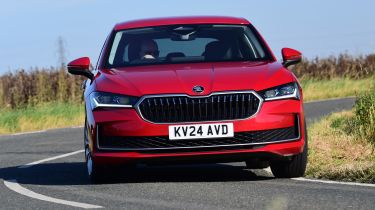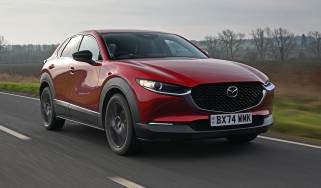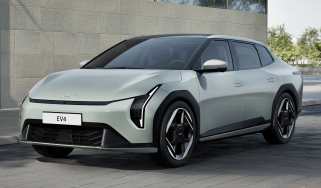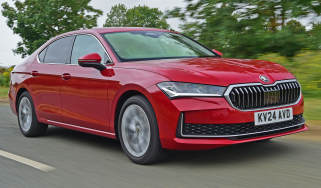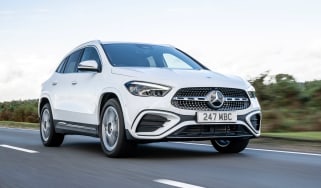Skoda Superb review – Engines, drive & performance
“It’s no speed demon, but the Superb is comfortable and smooth enough that the miles will slip by”
So far we’ve tried both the 148bhp 2.0-litre diesel engine and the 1.5-litre petrol with Skoda’s latest mild-hybrid technology across a mixture of roads in the UK. Both engines complement the Superb’s smooth and unhurried character, with enough grunt to accelerate smoothly. It may not be as sharp as a BMW, but the suspension does a good job of filtering out bumps from the cabin while still providing a reassuring feeling of stability at higher speeds and through corners.
Skoda added a SportLine trim level in August 2024, and while it doesn’t feature any performance upgrades like you’d expect of one of the brand’s vRS models, it gets a sports chassis lowered by 15mm and sports seats that hold you in place for a more composed drive. We’re yet to test it, but these changes should help it feel more agile than the rest of the range and it remains to be seen how this affects the ride quality, especially on the standard 19-inch wheels.
Is it good to drive in town?
The Skoda Superb feels perfectly at home around town despite its large dimensions. Its suspension is soft enough to absorb potholes, although if we’re being very picky, the 18-inch wheels fitted to our test car caused some fidgeting over smaller bumps. We expect the 17-inch wheels fitted to the entry-level Superb SE Technology to improve things, otherwise Skoda offers adaptive suspension for around £1,300 for SE models (they’re standard-fit with the L&K trim). We tested the system fitted to the Superb Estate and Comfort mode offered a very smooth around-town driving experience. While it’s not completely free of resistance at lower speeds, the steering is easy enough to twirl to make manoeuvring easy.
Is it good to drive on long journeys?
You can bet your bottom dollar on it. The Skoda Superb is intended to spend lots of its life cruising along the motorway network, and it does a fine job of sitting at the national speed limit. Its long wheelbase and supple suspension mean it never feels twitchy, and its new design is very aerodynamic (with a 10% reduction in drag to just 0.23Cd). There’s a bit of road noise at higher speeds, but very little wind noise.
Is it good to drive on B-roads?
While it’s hardly designed to carve up your favourite back road, the Superb should at least leave you feeling unruffled. There’s some body roll through corners, but it’s predictable and gives you a sense of how the car is behaving. It’s a safe, slightly nose-heavy setup, but that makes sense for a family car of this size. Perhaps the kindest thing we can say is that it doesn’t feel especially big from behind the wheel, even if at 4.9 metres from bumper to bumper it’s almost as long as a Range Rover.
Petrol models
We expect the vast majority of UK buyers will be interested in the entry-level petrol engine we’ve tested – the 1.5-litre four-cylinder with e-TEC mild-hybrid assistance, which represents the first time the tech has been seen in the Superb.
More reviews
It uses a starter generator to harvest some energy into a small battery under deceleration, allowing for engine-off coasting and a helping hand of electric power under acceleration. The stop-start system works well in heavy traffic and the Superb accelerates pretty smoothly, although sometimes the DSG automatic gearbox holds onto gears for a bit too long, resulting in a drone from the engine.
A 2.0-litre petrol engine is fitted to Superb L&K models, producing a healthier 261bhp, although that’s slightly down on the 276bhp of the old Superb Sportline. Still, it will crack the 0-62mph benchmark in under six seconds with the help of four-wheel drive traction, making this model quicker than a Volkswagen Golf GTI hot hatchback.
|
Model |
Power |
0-62mph |
Top speed |
|
Superb 1.5 TSI e-TEC DSG |
148bhp |
9.2s |
139mph |
|
Superb 2.0 TSI 4x4 DSG |
261bhp |
5.6s |
155mph |
Diesel models
Unlike quite a few rivals that have ditched diesel lately, the Skoda Superb is still offered with a 2.0-litre TDI engine. The 148bhp version is far from exciting, but it rarely left us wanting for more grunt. With 340Nm of torque, it’s more responsive at lower speeds than before, making it very easy to drive. We did find it to be a bit grumbly on occasion, but for the most part, it delivers a hushed driving experience.
It’s also worth noting that you can’t get the 148bhp diesel engine with four-wheel drive. For that, you’ll need to upgrade to the pricier 190bhp unit. The added traction of four-wheel drive will be useful for those who regularly drive in less-than-ideal conditions or those who plan to tow heavy trailers.
|
Model |
Power |
0-62mph |
Top speed |
|
Superb 2.0 TDI 148bhp DSG |
148bhp |
9.2s |
139mph |
|
Superb 2.0 TDI 190bhp DSG 4x4 |
190bhp |
7.5s |
147mph |
Plug-in hybrid models
It’s a shame the PHEV powertrain isn’t offered in the Superb hatchback, coming only in Estate form. It’s likely that Skoda is expecting the more practical bodystyle to be the bigger seller in the UK, and you can read our in-depth review on that model. It features a 1.5-litre petrol engine and electric motor for a combined 201bhp, while a larger battery pack than before extends its electric driving range to an impressive 82 miles.
Electric models
There’s no sign of an all-electric Superb on the horizon, so if you’d like a zero-emissions car in this class the closest equivalent is the Volkswagen ID.7. It boasts an impressive range of up to 384 miles, but prices start from around £50k, so it’s pricey to buy.
Which Is Best?
Cheapest
- Name1.5 TSI e-TEC SE Technology 5dr DSG
- Gearbox typeSemi-auto
- RRP£35,695
Most Economical
- Name2.0 TDI SE Technology 5dr DSG
- Gearbox typeSemi-auto
- RRP£36,210
Fastest
- Name2.0 TSI Sportline 4X4 5dr DSG
- Gearbox typeSemi-auto
- RRP£46,695
